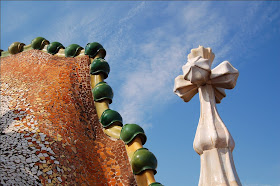
La Boqueria Mercat de Sant Josep
WHEELCHAIR-ACCESSIBLE MUST SEES & MUST EATS IN BARCELONA
• Gaudi’s Casa Batllo. It has a tiny elevator, but the staff has a loaner wheelchair small enough to fit in it so disabled visitors can enjoy all the floors in the highly ornamented masterpiece of the master architect.
• People watching on the Ramblas. The wide, pedestrian-only walkways are a wheelchair user’s dream. Enjoy the architecture, news stands and artisanal chocolate shops, but avoid the tourist trap cafes and beware of the pickpockets in the Sant Josep section of the lower Rambla.
• Barcelona Bus Turistic. These tourist buses have guides who describe the surroundings in many languages. But the real bonus is the buses are completely barrier-free via ramps and they stop at virtually every major attraction – from colorful Parc Guell on Mont Pelat to the Joan Miro museum on Montjuic.
• La Boqueria Mercat de Sant Josep. Barcelona is filled with fabulous fresh markets and the Boqueria -- with stall after stall of meat, cheese, produce, seafood, wine and more – is the granddaddy of them all.
• Lunch at Garduna. The downstairs bar area is accessible and dishes are prepared from ingredients selected from the adjacent Boqueria. Dinner at Quo Vadis, The classic Catalan restaurant serves sumptuous dishes such as quail and suckling pig in a grand, formal and barrier-free setting.
• Tapas at Lonja de Tapas. The barrier-free cafe offers small plates inside or out on picturesque Pla del Palau. Dessert at Xocoa. Everything is decadent and delicious at this totally accessible gourmet chocolate shop in La Ribera.
• Placa de Sant Jaume. This Roman-era plaza is mostly cobblestone, but there are smooth-paved walkways that allow wheelchair users to watch the parade of people past the Ajuntament, the 1300s Neo Classical and Gothic city hall.
• Museu d’Historia de la Ciutat. The city history museum, features the largest underground excavation of any ancient city in Europe. A recent renovation created outstanding wheelchair access via an elevator down to accessible boardwalks that meander among the ruins of Roman laundry and dyeing workshops as well as wine and fish sauce fermentation vats.
• Walking and rolling wheelchair accessible routes through neighborhoods such as Eixample, with early 20th century modern architecture; El Ravel, with dark and exotic cafes and bars in a rebounding but still rough around the edges district; and Gracia, with the narrow streets and small village charm of an eclectic place that was a stand alone town until annexed to Barcelona in the late 1900s.
• Sagrada Familia. Antoni Gaudi’s sacred masterpiece and surely the most famous unfinished building site in the world. Architect Gaudi started this church -- noted for its gothic towers, parabolic arches and high ornamentation – in 1882 and work will go on for decades before it is completed. Many areas are wheelchair-accessible.
--Steve Wright

Casa Batllo
No comments:
Post a Comment